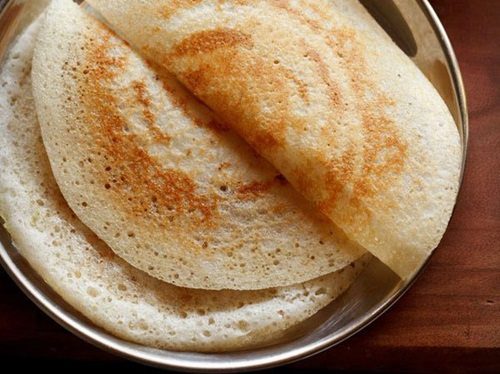Magic Dosa

Want to know a super simple + fun way to get more fermented foods in your diet? A Southern Indian staple, the dosa is a crepe made of fermented rice and lentils. This recipe fromnourishrealfood.comis a great one! Make a warming chutney…or scramble, or stir-fry, or favorite jam, or whatever you dream up![]() …and enjoy.
…and enjoy.
For the Dosa batter//
1 cup split skinned black lentils (known as urad dal)
3 cups of basmati rice
1 teaspoon fenugreek seeds
1 tsp sea salt
Rinse the split black lentils under cold water and cover them with about 3 inches of water. Let soak for about 6-8 hours or preferably overnight. Similarly soak the rice and fenugreek separately overnight.
Drain the lentils and nutribullet or blend or grind together with fenugreek seeds and water used for soaking the seeds to a smooth paste. Transfer to a deep bowl.
Drain and blend the rice in small batches to a gritty paste using little water. Transfer to the bowl containing the lentil paste and mix well.
Cover and let ferment in a warm spot (definitely not a cold spot) in your kitchen overnight. Ferment for 12-24 hours, depending on the temperature or until the batter appears to have doubled in volume. Once fermented, the batter should be frothy, a tad sour smelling and in a pouring consistency. Add salt and mix gently. If thick, add little water and mix till pouring consistency is achieved.
This batter can be refrigerated up to 1 week.
To make the dosas:
Preheat a 10 inch cast-iron skillet over high heat to allow the pan to heat up. Once hot, brush 1 tsp ghee on the pan. Ladle ¼ cup of batter on the hot pan. Using the back of your heat resistant ladle, swirl the batter in concentric circles to spread evenly. Drizzle a few drops of ghee on the sides of the dosa batter, letting it cook on low heat till the sizes start to leave the pan and the dosa turns crispy and golden brown in color. Now roll over or fold the dosa out of the pan and serve with your accompanying food.
More about the benefits of fermentation:
The fermentation process increases the bioavailability of nutrients like minerals present in food. Lactobacilli (the good guys!) produce an array of substances like Vitamins B, folic acid, riboflavin, niacin, thiamin and biotin, Vitamin K, and some antibiotic and anti-carcinogenic substances. These foods are predigested by bacteria, thereby easier to digest. The lactic acid and enzymes formed during the fermentation process aid digestion, especially protein digestion. This lactic acid also promotes the growth of a healthy intestinal flora.
The benefits are endless – and the recipes are endless! Let us know how you love this recipe, and where it took you next along your healthy+delicious culinary adventures![]() .
.
photo cred // nourishrealfood.com
